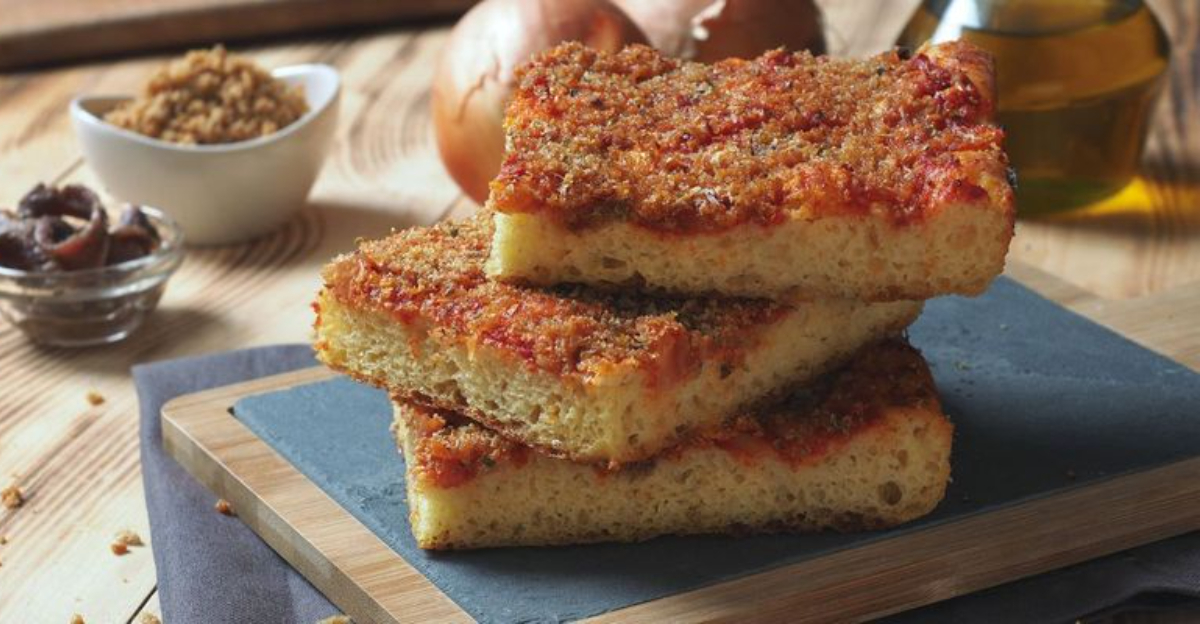Once-Popular Pizza Styles That Are Getting Harder To Find

Pizza has evolved dramatically since its humble beginnings in Naples, Italy. While pepperoni and cheese dominate modern menus, many fascinating pizza varieties have faded from the spotlight over time.
Regional specialties and old-world techniques that once defined pizzerias across America are becoming increasingly scarce.
Let’s explore eight pizza styles that were once neighborhood staples but now require a dedicated search to enjoy.
1. St. Louis-Style Pizza
Thin as a cracker with a distinctive sweetness, St. Louis-style pizza features Provel cheese instead of mozzarella. This processed cheese blend melts into a gooey layer that’s unmistakably different from standard pizza fare.
Outside Missouri, finding authentic Provel-topped pizza requires serious detective work. The unique square-cut pieces (called “party cut” by locals) create a no-tip end slice that pizza enthusiasts travel miles to experience.
2. Tomato Pie
Trenton, New Jersey’s claim to pizza fame reverses the typical layering by putting cheese directly on the dough and tomatoes on top. Served piping hot, this round pie prioritizes tangy tomato flavor above all else.
My grandfather took me to DeLorenzo’s every Sunday after church, where we’d watch bakers spread crushed tomatoes across the cheese-laden dough.
Today, only a handful of authentic tomato pie bakeries remain, most run by aging families with no succession plans.
3. Old Forge Style
From a tiny Pennsylvania coal mining town comes this rectangular pizza with a chewy, twice-proofed crust. Old Forge style features an unusual cheese blend of American, cheddar, and sometimes brick cheese, creating a distinct flavor profile.
Locals don’t even call it pizza, referring to it as “tray” (for a whole pizza) or “cut” (for a slice). Finding this regional specialty outside Lackawanna County is nearly impossible, as the technique remains closely guarded by a dwindling number of family restaurants.
4. New Haven White Clam Pizza
Connecticut’s coastal contribution to pizza culture skips tomato sauce entirely. Fresh littleneck clams, garlic, olive oil, oregano, and pecorino romano create a briny masterpiece on a coal-fired, slightly charred crust.
I once drove three hours just to taste Frank Pepe’s original white clam pie, joining a line that wrapped around the block.
The tradition of coal ovens faces challenges from modern health regulations, making authentic versions increasingly rare outside a few historical establishments.
5. Greek-Style Pizza
Popular throughout New England in the 1970s, Greek-style pizza features a puffy, oily crust baked in shallow pans.
The signature approach includes heavy oregano, a blend of cheddar and mozzarella, and olive oil-soaked bottoms. Greek immigrants who dominated the Northeast pizza scene created this distinct style.
As original owners retire, many restaurants convert to mainstream pizza styles, making the authentic version increasingly difficult to locate despite its once-ubiquitous presence in Massachusetts and Rhode Island.
6. Quad City-Style Pizza
Spanning the Iowa-Illinois border region, Quad City pizza features a nutty, malt-infused crust, spicy tomato sauce, and toppings under the cheese. The most distinctive feature is the scissor-cut strips rather than triangular slices.
Growing up near Davenport, my family celebrated every Little League victory with these unique strips. The scissor-cutting technique creates the signature long, narrow pieces that locals call “strips” rather than slices.
As original pizzerias close, finding authentic versions requires increasingly specific knowledge of remaining family operations.
7. Bar Pizza
South Shore Massachusetts developed this 10-inch personal pizza cooked in well-seasoned steel pans. The ultra-thin crust extends to the very edge with no raised border, creating a crispy cheese perimeter that defines the style.
Traditionally served in taverns without plates, bar pizza was designed to maximize beer sales. The pans, seasoned over decades, contribute distinctive flavors that can’t be replicated.
With many original bars closing or modernizing menus, this regional specialty faces an uncertain future.
8. Bakery Pizza (Sfincione)
Sicilian immigrants brought this focaccia-like creation to American bakeries, not pizzerias. Topped with breadcrumbs, onions, and sometimes anchovy-infused tomato sauce, bakery pizza was sold at room temperature by the square.
Traditional Italian bakeries once offered these slices wrapped in white paper as afternoon snacks. Modern commercial bakeries rarely maintain this labor-intensive specialty.
The few remaining examples exist in old-neighborhood bakeries where elderly bakers still prepare dough using handed-down techniques that predate modern commercial yeast.
